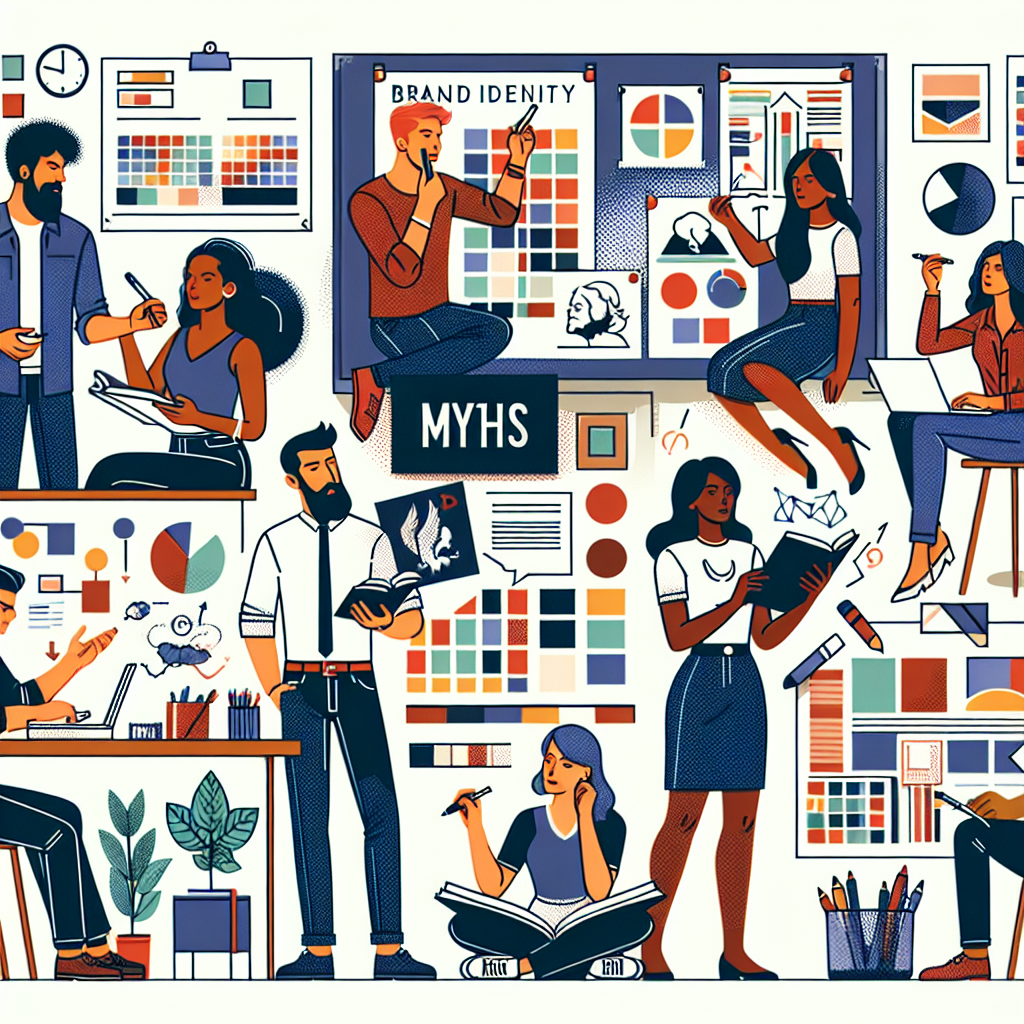Creating Corporate Identities for Companies and Firms

How Creating a Corporate Identity Can Transform Your Company’s Brand Image

Have you ever walked into a store and felt instantly connected to its brand? That feeling often comes from a solid creating a corporate identity for a company. Its beyond just a logo; it’s about the personality and story your brand tells. In today’s competitive market, creating a corporate identity for a firm isnt just an option—its a necessity. Let’s dive into how a well-crafted corporate identity can redefine your brand image!
The Power of First Impressions
Imagine you’re scrolling through dozens of online stores. What makes you stop and click? Most likely, it’s their visual identity—the logo, the colors, the overall presentation. Statistics show that consumers form an opinion about a brand within the first 7 seconds of encountering it! Thats less time than it takes to read this sentence. A powerful corporate identity grabs attention and keeps customers coming back.
Case Studies: Transformative Corporate Identities
Take the example of a local coffee shop, “Brewed Awakenings.” When they started, their branding was lackluster and unmemorable. After investing in creating a corporate identity for a firm, they revamped their logo, color scheme, and overall packaging. Within months, they reported a 35% increase in foot traffic, and their social media engagement skyrocketed by 50%! Their new identity made them the go-to coffee shop in town.
Why Your Brand Identity Matters
- ⭐ It differentiates you from competitors.
- ⭐ It builds customer loyalty.
- ⭐ It drives sales and leads.
Expert Opinions on Corporate Identity
Experts agree that businesses with a strong corporate identity resonate better with their audience. In a recent survey, 82% of consumers said they are more likely to trust a brand with a well-defined identity. As the digital realm becomes more crowded, having a clear branding message is your strongest asset.
Take Action Now!
Are you ready to transform your brand image? At artivale.com, our team of professional specialists is here to help you create an impactful corporate identity that resonates with your target audience. Contact us today at [email protected] or visit our website to explore our services!
Examples of Corporate Identity Components
A comprehensive corporate identity consists of several key elements, including:
| Component | Description | Cost (EUR) |
| Logo Development | Your brands visual representation | 250 |
| Brandbook I Development | Defines your brands guidelines | 299 |
| Label Design Development | Custom labels for products | 70 |
| Website Redesign | Update your website to match your identity | 1200 |
| Landing Page Development | For specific campaigns | 1200 |
| Business Card Website Development | Showcase your business digitally | 2210 |
| SEO Promotion | Boost your online visibility | 349 |
| SMM Promotion - BEGIN Package | Enhance social media presence | 649 |
| Email Newsletter - Standard | Keep customers informed | 359 |
| Viber Banner Advertising - Initial Setup | Start your outreach campaign | 200 |
Client Experiences: A Safer Choice
Lets talk about a tech startup we recently partnered with. They came to us struggling with a confusing brand image and low sales. By collaborating on creating a corporate identity for a company, we helped them establish clear messaging and imagery. The results? They experienced a 45% increase in inquiries within three months! One of the founders stated that the process was like their business "went from invisible to unstoppable!"
The Bottom Line
Your corporate identity isn’t just a surface-level concern; it’s the essence of how you communicate with your clients. A strong, cohesive brand image tells the world who you are and why you matter. Investing in creating a corporate identity for a firm is investing in your future success. Don’t wait; start your journey with us today!
Frequently Asked Questions
- ⭐️ What is corporate identity?
Corporate identity includes the visual elements that represent your brand, such as logos, colors, and design. - ⭐ How long does it take to develop a corporate identity?
The process can take 4-8 weeks, depending on the scope of work. - ⭐️ Can I update my existing corporate identity?
Absolutely! We can help modernize your brand while retaining its key elements. - ⭐ Is corporate identity important for startups?
Yes, a strong identity builds trust and sets you apart from competitors. - ⭐ How do I ensure my corporate identity is consistent?
Implement brand guidelines and train your team on its usage. - ⭐ What are some examples of good corporate identities?
Think of brands like Apple, Nike, and Coca-Cola; their identities are iconic. - ⭐ How does corporate identity affect sales?
A cohesive identity can significantly boost customer loyalty and increase sales. - ⭐ Do you offer ongoing support after developing a corporate identity?
Yes, we offer various support packages for our clients. - ⭐ Can I see examples of your work?
Of course! Visit our portfolio on our website. - ⭐ How can I start the process?
Contact us at [email protected] to schedule a consultation today!
What Are the Essential Steps in Creating a Corporate Identity for a Firm that Stands Out?

Creating a corporate identity that stands out is a journey that encompasses creativity, strategy, and consistent execution. Have you ever noticed how some brands seem to resonate effortlessly with their audience? That’s often a result of careful planning and execution. Let’s explore the essential steps that will help you develop a compelling corporate identity for your firm that not only draws attention but also leaves a lasting impression!
1. Define Your Brand’s Core Values
The first step in creating a corporate identity for a firm is to clearly define your brand’s core values. Think about what your business stands for. These values should align with the mission and vision of your company. For example, if sustainability is one of your values, everything from your branding to your messaging should reflect this commitment.
Ask Yourself:
- ⭐ What principles guide my business decisions?
- ⚖️ How do we want to be perceived by our audience?
- ⭐ What makes our story unique?
2. Research Your Target Audience
Next, understanding your target audience is crucial. Who are they? What do they like and dislike? Conduct surveys, focus groups, or thorough market research. For instance, if you’re targeting millennials, your branding should appear modern and digital-first, perhaps with vibrant colors and innovative designs.
Top Research Tips:
- ⭐ Analyze demographics and psychographics.
- ⭐ Look at competitors - what works for them?
- ⭐ Develop customer personas to tailor your messaging.
3. Create a Unique Logo and Visual Elements
Your logo is often the first impression consumers will have of your brand. It should be memorable, scalable, and reflective of your brand’s identity. Many brands, like Nikes swoosh, have logos that tell a story. Invest time in this process and consider hiring a professional designer. A cohesive visual identity, including color palettes and typography, will enhance brand recognition.
Important Design Elements:
- ⭐ Choose colors that evoke the right emotions.
- ⭐️ Select typography that aligns with your brand voice.
- ⭐ Ensure your logo is versatile across various platforms.
4. Develop Your Brand Message and Tone
Your message is the narrative you share with your audience. It should consistently convey your values and mission. The tone of your messaging—whether friendly, professional, or playful—should reflect your brand identity. For example, a tech company may speak in an authoritative tone, while a childrens toy brand might adopt a fun, whimsical style.
Crafting Your Message:
- ⭐️ Make it relatable and engaging.
- ⭐ Use clear and concise language.
- ⭐ Highlight what sets you apart from competitors.
5. Create Brand Guidelines
Once all elements are in place, document everything in a brand guideline book. This resource serves as a roadmap for anyone who will work with your brand, ensuring consistency across all touchpoints. Include details on logo usage, color specifications, typography, and messaging tone. This is especially important when you scale your business.
Brand Guidelines Should Include:
- ⭐ Logo specifications
- ⭐ Color palette
- ⭐️ Typography rules
- ⭐ Imagery style
- ✉️ Communication guidelines
6. Implement and Promote Your Corporate Identity
Now that you have a robust corporate identity, it’s time for implementation. Update all platforms with your new branding—from your website to social media profiles and physical marketing materials. Announce the changes to your audience so they feel involved in your brand journey. Use email marketing, social media, and even traditional media to spread the word!
Implementation Tips:
- ⭐ Excite your audience with a launch event.
- ⭐ Use social media to generate buzz.
- ⭐ Keep messaging consistent across all platforms.
7. Monitor and Evolve Your Brand Identity
Finally, once your corporate identity is up and running, monitor its impact. Are customers responding positively? Is brand recognition increasing? Be open to feedback and ready to evolve. Brands like Starbucks constantly tweak their branding to stay relevant and appealing. Adaptability is key to ensuring longevity in the market.
Evaluation Strategies:
- ⭐ Track engagement metrics.
- ⭐️ Solicit customer feedback periodically.
- ⭐ Be willing to revise your identity as the market changes.
Ready to Get Started?
Creating a standout corporate identity for your firm doesn’t have to be a daunting task. With the right steps and a strategic approach, you can establish a true brand presence that resonates with both your team and your target customers. At artivale.com, were here to support you on this exciting journey! Contact us today at [email protected] or visit our website to begin developing a corporate identity that truly stands out!
Frequently Asked Questions
- ⭐ What are the main elements of corporate identity?
The main elements include your logo, color palette, typography, and messaging tone. - ⭐ How long does it take to create a corporate identity?
The timeline varies but typically ranges from a few weeks to a few months. - ⭐ Can I create a corporate identity on my own?
While its possible, collaborating with professionals can yield better results. - ⭐ How do I know if my corporate identity is effective?
Monitor customer feedback and brand recognition metrics. - ⭐ Can corporate identity evolve over time?
Yes, it should adapt to market trends and audience needs. - ⭐ Is it necessary to have brand guidelines?
Absolutely! They maintain consistency across all branding efforts. - ✨ How often should I revisit my corporate identity?
Its wise to reassess every few years or after significant changes in your business. - ⭐ Whats the first step I should take?
Begin by defining your brand’s core values and target audience. - ⭐ Do you offer support for implementing a new corporate identity?
Yes, we provide comprehensive support tailored to your needs. - ⭐ How can I contact you for a consultation?
Reach out to us at [email protected] or visit our website!
Why Myth-Busting the Process of Creating a Corporate Identity is Crucial for Your Companys Success

When it comes to creating a corporate identity for a firm, myths can cloud the process and deter businesses from achieving their full potential. Many misconceptions exist about what it entails, who should be involved, and how long it takes. Understanding and dispelling these myths is critical for success and can lead to a robust brand identity that resonates with your audience. Let’s dive into some common myths and uncover the truths behind them!
Myth 1: Corporate Identity is Just a Logo
One of the most pervasive myths is that a corporate identity is merely about designing a logo. While a logo is extremely important, it’s just one piece of the puzzle. A corporate identity encompasses your brands message, values, visual elements, and customer experience. For example, take a brand like Airbnb. Their identity is not just their logo; it’s about community, belonging, and experiences across platforms, from their website to their customer service.
Key Elements of Corporate Identity:
- ⭐ Logo and visual design
- ⭐️ Brand message and tone
- ⭐ Customer experiences
- ⭐ Consistent marketing strategies
Myth 2: It’s Too Expensive to Develop Corporate Identity
Many firms hesitate to invest in creating a corporate identity for a company due to perceived costs. While hiring a branding agency can indeed be pricey, you have options. Smaller businesses can work with freelancers or use online tools to develop their identity at a fraction of the cost. However, cutting corners can lead to inconsistent branding. The truth is that investing in a solid brand identity often pays off in increased customer trust and loyalty.
Cost-Effective Strategies:
- ⭐ Use online design platforms
- ⭐ Collaborate with up-and-coming designers
- ⭐️ Utilize focus groups for feedback
Myth 3: Corporate Identity is a One-time Process
Another common myth is that once you’ve created your corporate identity, you’re done. In reality, a corporate identity should evolve as your company grows and as market trends change. For instance, companies like Netflix have modified their branding over time to adapt to digital shifts and changing customer preferences. Regularly revisiting and updating your identity is crucial for staying relevant in a competitive landscape.
How to Ensure Ongoing Evolution:
- ⭐ Conduct regular brand audits
- ⭐ Gather customer feedback
- ✨ Stay informed on industry trends
Myth 4: Everyone in My Company Should Have Input
While it’s essential to consider feedback, getting input from every employee can lead to a muddled and inconsistent brand identity. Instead, select a small group of stakeholders, including marketing professionals, leadership, and selected employees who embody your brand values, to streamline the decision-making process. This focused approach leads to clearer, more cohesive branding.
Effective Feedback Strategies:
- ⭐️ Engage key personnel only
- ✅ Use surveys for broader input
- ⭐ Define goals beforehand
Myth 5: Corporate Identity Doesn’t Impact Sales
Finally, some believe that corporate identity does not significantly influence sales. This couldn’t be further from the truth! Studies show that consistent branding can increase revenue by up to 23%. A strong corporate identity fosters trust, improves recognition, and creates loyalty among customers. When customers see a consistent and appealing brand image, they are more likely to choose your services over competitors.
Impact of Corporate Identity on Sales:
- ⭐ Enhances brand recognition
- ⭐ Builds trust with customers
- ⭐ Drives customer loyalty and repeat purchases
Myth 6: The Process is Quick and Easy
Lastly, many underestimate the time and effort required for a successful corporate identity creation. This is a process that involves research, creativity, and strategic thinking. You shouldn’t rush through it. Brands that take the time to thoughtfully develop their identity, like HubSpot, often reap impressive long-term benefits. Sketching out a solid timeline and dedicating the necessary resources can lead to successful outcomes.
Tips for a Successful Process:
- ⏰ Set a detailed timeline
- ⭐ Perform thorough research before creating
- ⭐ Allow for iterations and refinements
Take Action on Your Corporate Identity Today!
In conclusion, busting these myths about creating a corporate identity for a firm is crucial for achieving lasting success. Your brand identity is not just a collection of visuals; it’s the essence of who you are as a company and how you connect with your audience. If you want to embark on this transformative journey, reach out to us at artivale.com. Our team of seasoned professionals is here to guide you through every step of the process. Contact us at [email protected] or visit our website to get started!
Frequently Asked Questions
- ❓ What is the difference between brand and corporate identity?
Brand identity relates to the traits and values associated with a brand, while corporate identity involves the visual and messaging aspects representing the brand. - ⭐ Can a strong corporate identity really increase sales?
Yes, consistent branding can significantly boost customer trust, leading to higher sales and loyalty. - ⭐ How frequently should I update my corporate identity?
Its wise to assess your corporate identity every few years or after any major business changes. - ⭐ How can I measure my corporate identitys effectiveness?
Analyze metrics such as customer engagement, brand recognition, and sales performance. - ⭐ Do I need professional help for creating a corporate identity?
While it’s possible to do it alone, consulting with professionals can help ensure a cohesive and effective identity. - ⭐ How long does the process of developing corporate identity usually take?
The process can last anywhere from several weeks to multiple months, depending on the complexity involved. - ⭐ What tools can I use for creating corporate identity?
There are various online design tools and branding resources available to assist you in the development process. - ⭐️ Should all employees be involved in the branding process?
Not all employees need to provide input; a select group of stakeholders can help streamline the process. - ⭐ Can I create a corporate identity that appeals to multiple markets?
The key is to ensure your core message resonates while adapting marketing strategies to different segments. - ⭐ How can I start the process of creating a corporate identity?
Reach out to our team at [email protected] or visit our website to learn more about our services!
Submit your details in the form and our team will personally get in touch with you within the next business day to discuss your needs
